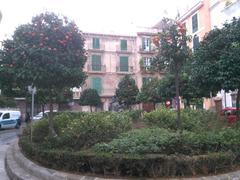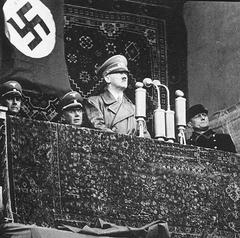Square of Resurrection in Klaipeda City, Lithuania: Visiting Hours, Tickets, and Historical Insights
Date: 23/07/2024
Introduction
The Square of Resurrection in Klaipeda City, Lithuania, stands as a remarkable testament to the city’s rich and diverse history. Nestled in the heart of Klaipeda, this historical and cultural landmark is a vibrant public space that encapsulates the essence of the city’s heritage. From its origins in the medieval period under the Teutonic Knights to its modern-day significance, the square has been a central part of Klaipeda’s urban and social fabric. Visitors to the Square of Resurrection can immerse themselves in a multifaceted historical journey that includes influences from the Hanseatic League, Swedish and Prussian rule, and the transformative events of the 19th and 20th centuries (Klaipeda Tourism, Hanseatic League, Prussian History, German Empire, Klaipeda Revolt, Soviet Union, Lithuania Independence). Today, the square is not only a historical site but also a hub for cultural events, social gatherings, and public celebrations, reflecting Klaipeda’s resilience and vibrant community life (Klaipeda Culture).
Table of Contents
- Introduction
- Historical Background
- Architectural Highlights
- Cultural Significance
- Visitor Information
- Travel Tips and Nearby Attractions
- Preservation Efforts
- FAQ
- Conclusion
- References
Historical Background
Origins and Early History
The Square of Resurrection, located in the heart of Klaipeda City, Lithuania, has a rich and multifaceted history dating back to the medieval period. Originally known as Memel, Klaipeda was founded in 1252 by the Teutonic Knights, a German medieval military order. The city was strategically important due to its location at the mouth of the Akmena-Danė River, providing access to the Baltic Sea. The square itself was part of the early urban planning and served as a central gathering place for the community (Klaipeda Tourism).
Teutonic Order and Hanseatic League
During the 14th and 15th centuries, Klaipeda became a significant member of the Hanseatic League, a commercial and defensive confederation of merchant guilds and market towns in Northwestern and Central Europe. The Square of Resurrection was a focal point for trade and commerce, hosting markets and fairs that attracted merchants from across the region. The Teutonic Order’s influence waned after the Battle of Grunwald in 1410, but the city’s economic importance continued to grow (Hanseatic League).
Swedish and Prussian Rule
In the 17th century, Klaipeda came under Swedish control during the Northern Wars. The Square of Resurrection witnessed several military parades and public gatherings during this period. However, the Treaty of Oliva in 1660 transferred the city to the Duchy of Prussia. Under Prussian rule, the square was modernized, and several significant buildings were constructed around it, including administrative offices and merchant houses (Prussian History).
19th Century Developments
The 19th century was a transformative period for Klaipeda and the Square of Resurrection. The city became part of the German Empire in 1871, leading to significant urban development. The square was redesigned to include a park and a monument commemorating the city’s history. It became a popular spot for social gatherings, public speeches, and cultural events. The introduction of railways and improved port facilities further boosted the city’s economic status (German Empire).
Interwar Period and Lithuanian Independence
After World War I, Klaipeda was placed under the administration of the League of Nations. In 1923, the Klaipeda Revolt led to the city’s annexation by Lithuania. The Square of Resurrection was renamed to reflect the city’s new status and became a symbol of Lithuanian independence and national pride. Various public events, including independence day celebrations and political rallies, were held in the square (Klaipeda Revolt).
World War II and Soviet Era
World War II brought significant upheaval to Klaipeda. The city was heavily bombed, and many historical buildings around the Square of Resurrection were destroyed. After the war, Klaipeda was annexed by the Soviet Union, and the square was renamed to reflect Soviet ideology. It became a site for military parades and communist rallies. The Soviet government also undertook reconstruction efforts, rebuilding several structures and adding new monuments (Soviet Union).
Post-Soviet Era and Modern Developments
With the dissolution of the Soviet Union in 1991, Klaipeda regained its independence as part of Lithuania. The Square of Resurrection was restored to its pre-Soviet name and underwent significant renovations. Modern developments have focused on preserving the historical essence of the square while incorporating contemporary elements. Today, it serves as a vibrant public space hosting cultural events, markets, and festivals, reflecting the city’s rich historical tapestry (Lithuania Independence).
Architectural Highlights
The architectural landscape of the Square of Resurrection is a testament to its diverse historical influences. Notable buildings include the neo-Gothic Post Office, constructed in the late 19th century, and the Art Nouveau-style Drama Theatre, which has been a cultural hub since its establishment in the early 20th century. The square also features several modern sculptures and installations that pay homage to the city’s past and present (Klaipeda Architecture).
Cultural Significance
The Square of Resurrection holds immense cultural significance for the residents of Klaipeda. It is a symbol of resilience and rebirth, reflecting the city’s ability to overcome historical challenges and emerge stronger. The square is a focal point for community life, hosting various cultural and social events throughout the year. It is also a popular destination for tourists, offering a glimpse into the city’s rich history and vibrant present (Klaipeda Culture).
Visitor Information
Ticket Prices
Visiting the Square of Resurrection is generally free of charge. However, some events and exhibitions held in the square may require tickets. It’s advisable to check the official website or local tourist information centers for the latest details.
Visiting Hours
The Square of Resurrection is open to the public 24/7. However, individual attractions within the square, such as museums or cultural centers, may have specific opening hours.
Accessibility
The square is accessible to visitors with disabilities, with paved paths and ramps available for easy navigation. Public restrooms are also equipped to accommodate those with special needs.
Travel Tips and Nearby Attractions
- Weather: Klaipeda experiences a maritime climate, so it’s advisable to check the weather forecast and dress accordingly.
- Transport: The square is easily accessible by public transport, including buses and trams. Parking facilities are also available nearby.
- Nearby Attractions: Don’t miss the Klaipeda Castle Museum and the Lithuanian Sea Museum, both of which are within walking distance of the square.
Preservation Efforts
Efforts to preserve the historical and cultural integrity of the Square of Resurrection are ongoing. The local government, in collaboration with heritage organizations, has implemented several initiatives to maintain and restore historical structures and monuments. These efforts ensure that the square remains a living testament to Klaipeda’s storied past while continuing to serve as a dynamic public space for future generations (Heritage Preservation).
FAQ
What are the visiting hours for the Square of Resurrection?
The square is open to the public 24/7, but individual attractions within the square may have specific opening hours.
Do I need tickets to visit the Square of Resurrection?
Visiting the square is generally free, but some events and exhibitions may require tickets.
Is the Square of Resurrection accessible to people with disabilities?
Yes, the square is equipped with paved paths and ramps, making it accessible to visitors with disabilities.
Conclusion
In summary, the Square of Resurrection in Klaipeda City is an essential destination for anyone interested in exploring Lithuania’s rich historical and cultural tapestry. From its medieval origins under the Teutonic Knights to its role as a symbol of Lithuanian independence and resilience, the square has witnessed significant historical transformations. Today, it serves as a dynamic public space hosting a variety of cultural events, markets, and festivals, making it a vibrant part of Klaipeda’s community life. Visitors can enjoy the square’s architectural highlights, learn about its historical significance, and participate in the many activities and events that take place throughout the year. The efforts to preserve and maintain this landmark ensure that it remains a living testament to Klaipeda’s storied past and its ongoing cultural vitality (Heritage Preservation, Klaipeda Architecture). Whether you are a history enthusiast, a cultural explorer, or a casual tourist, the Square of Resurrection offers a memorable and enriching experience.
References
- Klaipeda Tourism, n.d., Klaipeda Tourism source
- Hanseatic League, n.d., Hanseatic League source
- Prussian History, n.d., Encyclopædia Britannica source
- German Empire, n.d., Encyclopædia Britannica source
- Klaipeda Revolt, n.d., Encyclopædia Britannica source
- Soviet Union, n.d., Encyclopædia Britannica source
- Lithuania Independence, n.d., Encyclopædia Britannica source
- Klaipeda Culture, n.d., Klaipeda Tourism source
- Heritage Preservation, n.d., Lithuanian Cultural Heritage Department source
- Klaipeda Architecture, n.d., Klaipeda Tourism source

